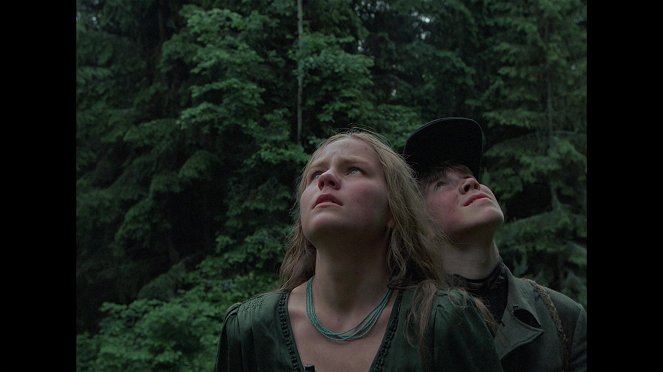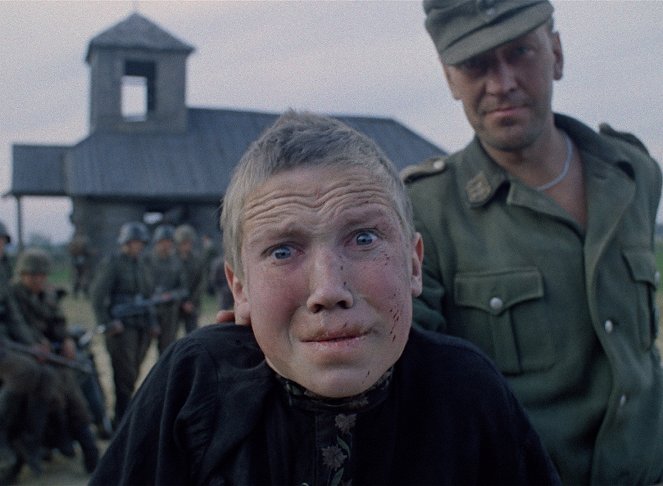Directed by:
Elem KlimovCinematography:
Aleksey RodionovVOD (2)
Plots(1)
This legendary film from Soviet director Elem Klimov is a senses-shattering plunge into the dehumanizing horrors of war. As Nazi forces encroach on his small village in Belorussia, teenage Flyora (Alexei Kravchenko, in a searing depiction of anguish) eagerly joins the Soviet resistance. Rather than the adventure and glory he envisioned, what he finds is a waking nightmare of unimaginable carnage and cruelty—rendered with a feverish, otherworldly intensity by Klimov’s subjective camera work and expressionistic sound design. Nearly blocked from being made by Soviet censors, who took seven years to approve its script, Come and See is perhaps the most visceral, impossible-to-forget antiwar film ever made. (Criterion)
(more)Videos (1)
Reviews (7)
Boredom – boredom – powerful scene. Boredom – filler – powerful scene. Filler – filler – hugely powerful scene. Over and over. A strong, but not at all exception message (you can “find" it elsewhere), and it doesn’t really work as a movie; it is too unrefined in its messages and puts its money on the gut reaction to wartime atrocities. But if you let the distinctive rhythm of the storytelling wave over you and allow yourself be stirred from you trance only for the powerful scenes, then you will find this a rewarding watch. So it’s a sort of “wake up and take a look" affair.
()
In its apocalyptic and surreal visions, crowned with typical Russian reckless abandon (cheerful partisans fleeing from gunfire with a mocking scarecrow in the form of a life-size Hitler), the film is certainly at its strongest, and its attempt to portray the occupation as a bloody mess on wheels gives the impression of a traumatic childhood memory or a pointless nightmare. There is a flip side to this, however, which is that at times the film goes beyond anti-Germanic exploitation as it hysterically enumerates all the stereotypes of Nazi occupiers snacking on lobsters while burning down churches full of people, breeding exotic monkeys, and when they are finally caught red-handed, either cowardly blaming one another or delivering a focused monologue about the need to annihilate the Slavic race. It's clear to me that, given that co-writer Adamovich was an actual witness to similar events and the script itself was based on dozens of survivor testimonies, it's hard to ask for any kind of detachment in the treatment of such themes, but the picture of absolute evil without context that we are presented with here seems a bit over the top in those two scenes.
()
A tragic image of war, destroying everything not only physically but forever destroying even those who were not directly affected at first sight. The expression on the main protagonist's face speaks for itself - attempting to squeeze such horror and inhumanity, which he witnessed, into ordinary (not only cinematic) phrases is simply impossible. Just like it is impossible to truly comprehend the fact of more than 20,000,000 killed inhabitants of the Soviet Union, truly enormous, yet still only one single country. The final scene is thus an example of the genius of the film, and of cinema itself.
()
Yuck! It's not "yuck" in terms of the film's quality, but it's "yuck" in terms of what a person is capable of. I know, it's just a movie, but it could easily be a documentary because these atrocities do happen. And sometimes you don't even need blood to be knocked out by a scene. For example, the photo shoot is incredibly scary.
()
Come and See was a film once shown as part of the month of Czechoslovak-Soviet friendship, which was a diplomatic label for a bag of ideological crap and indigestible nonsense that had to be endured during obligatory visits to the movie theater, where high school students were herded by their teachers. It was my first encounter with Soviet perestroika, a war film that denied all previous notions of Soviet film-making. From the first panoramic shot and the somber sound of the airplane engine, I felt that this was simply in a different league. It is an extraordinarily emotional war film filmed from the perspective of the main protagonist, a young teenager who wants to join a partisan unit and survives the massacre of the inhabitants of two Belarusian villages. In the scene where he survives the bombing and temporarily loses his hearing, the viewer also does not hear the surrounding gunfire and the noise of explosions. The horror is unfiltered and the violence is strongly naturalistic. It is simply a war film filmed from the perspective of the victims, not from the perspective of the filmmaker or military historian. By the way, it is based on real events that took place during the clearance operations of German units and Latvian raiding detachments in northern Belarus. In total, two million people died in this genocide. The scenes of the extermination of the village residents driven into a large barn then circled the entire film world, and director Elem Klimov became a globally respected filmmaker. He worked excellently with the film as a whole, the semi-whole, and with the details, so even years later, I still perfectly remember several scenes, especially Florya's night next to a dying cow hit by a burst of machine gun fire. I consider the shot of the dying animal's eye to be one of the highlights of my film experiences so far. The final scene, where the main character shoots at a picture of Hitler thrown on a muddy road, and the look in his eyes, is one of the most emotional and touching experiences that watching a film has ever brought me. Overall impression: 100%.
()



Ads